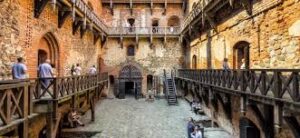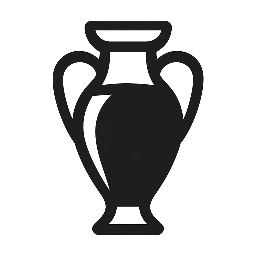Your basket is currently empty!
Introduction
In the heart of Lithuania, nestled on an island in Lake Galvė, lies one of the most iconic symbols of Lithuanian heritage – Trakai Castle. More than a scenic landmark, Trakai served as a military stronghold and political center during the peak of the Grand Duchy of Lithuania. Built in the 14th century, this medieval island fortress played a crucial role in the defense against external invaders, especially during conflicts with the Teutonic Knights.
Origins and Strategic Location
Trakai Castle was founded by Grand Duke Kęstutis in the mid-14th century. Located just 28 km west of Vilnius, its position was of strategic importance. Surrounded by lakes, the Island Castle of Trakai was almost impenetrable, offering both natural defense and control over important trade and military routes.
The location of Trakai was not a coincidence – it was deliberately chosen to protect the capital city of Vilnius from western invasions. The lakes surrounding the castle, including Lake Galvė, Lake Luka, and Lake Totoriskiu, formed a natural moat, making any assault a logistical nightmare for enemy forces.
Architecture and Defensive Features
Trakai Castle stands out for its red-brick Gothic architecture, which was rare in Lithuania at the time. The construction took place in two main phases:
-
Initial Phase (1360s–1380s): Defensive walls, towers, and residential quarters were established under Kęstutis.
-
Reconstruction and Expansion (1390s–1409): After damage from the Teutonic Knights’ attacks, Grand Duke Vytautas rebuilt and fortified the castle further, turning it into a luxurious Gothic palace and military base.
Key Defensive Features Included:
-
Thick walls (up to 2.5 meters)
-
Corner towers with arrow slits
-
A drawbridge connecting the island to the mainland
-
Inner courtyard designed for efficient troop movement
-
Moat systems integrated with the surrounding lakes
Role in Lithuanian Defense

During the 14th and early 15th centuries, Lithuania faced constant pressure from the Teutonic Order, which sought to Christianize and conquer the Baltic pagans. Trakai Castle served as a bastion of resistance.
Notable military functions:
-
Defense against Teutonic incursions
-
Garrison base for Lithuanian troops
-
Refuge and rallying point during regional conflicts
-
Political and diplomatic hub, especially under Grand Duke Vytautas the Great
Vytautas used Trakai as a residence and center of power, conducting negotiations and overseeing military strategy from within its walls.
The Battle of Grunwald and Trakai’s Peak
One of the most significant moments for Trakai Castle came during the Battle of Grunwald (1410). Although the battle itself took place in modern-day Poland, the troops trained and mobilized from various Lithuanian strongholds, including Trakai.
The decisive victory against the Teutonic Knights marked a turning point, and Trakai Castle became a symbol of Lithuanian resilience and independence.
Decline and Restoration
After the 16th century, Trakai Castle lost its military importance due to advancements in warfare and shifting political centers. It fell into ruin over the following centuries, especially after suffering damage during wars with Russia.
However, the 20th-century restoration efforts brought Trakai Castle back to life. Using historical documents and archaeological findings, the castle was rebuilt between 1951 and 1961, restoring its medieval grandeur.
Today, it stands as:
-
A popular tourist destination
-
A museum of Lithuanian history
-
A symbol of national pride
Why Trakai Castle Matters Today
Trakai Castle is not only a picturesque tourist site but a monument to Lithuanian sovereignty. Its history is deeply tied to the nation’s fight for survival and independence during the medieval period. As one of the few island castles in Eastern Europe, it represents unique medieval engineering and strategic military planning.
SEO Keywords Recap:
-
Trakai Castle
-
Lithuanian defense
-
Medieval Lithuania
-
Island Castle
-
Grand Duchy of Lithuania
-
Teutonic Knights
-
Vytautas the Great
Conclusion
Trakai Castle is a lasting reminder of Lithuania’s medieval might, strategic ingenuity, and cultural legacy. From defending against the Teutonic Order to hosting royal figures like Vytautas the Great, this island fortress has stood at the center of Lithuania’s dramatic past. Whether viewed through the lens of military history or architectural beauty, Trakai Castle remains a cornerstone of Lithuanian identity.
Want to dive deeper into Castles and Fortresses? Don’t miss our articles on Castles category.

